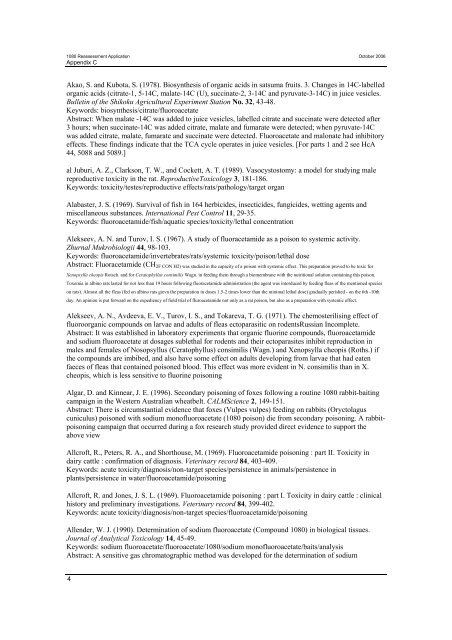Source: Landcare Research (1964). Control of poisons. Royal ...
Source: Landcare Research (1964). Control of poisons. Royal ...
Source: Landcare Research (1964). Control of poisons. Royal ...
Create successful ePaper yourself
Turn your PDF publications into a flip-book with our unique Google optimized e-Paper software.
1080 Reassessment Application October 2006<br />
Appendix C<br />
Akao, S. and Kubota, S. (1978). Biosynthesis <strong>of</strong> organic acids in satsuma fruits. 3. Changes in 14C-labelled<br />
organic acids (citrate-1, 5-14C, malate-14C (U), succinate-2, 3-14C and pyruvate-3-14C) in juice vesicles.<br />
Bulletin <strong>of</strong> the Shikoku Agricultural Experiment Station No. 32, 43-48.<br />
Keywords: biosynthesis/citrate/fluoroacetate<br />
Abstract: When malate -14C was added to juice vesicles, labelled citrate and succinate were detected after<br />
3 hours; when succinate-14C was added citrate, malate and fumarate were detected; when pyruvate-14C<br />
was added citrate, malate, fumarate and succinate were detected. Fluoroacetate and malonate had inhibitory<br />
effects. These findings indicate that the TCA cycle operates in juice vesicles. [For parts 1 and 2 see HcA<br />
44, 5088 and 5089.]<br />
al Juburi, A. Z., Clarkson, T. W., and Cockett, A. T. (1989). Vasocystostomy: a model for studying male<br />
reproductive toxicity in the rat. ReproductiveToxicology 3, 181-186.<br />
Keywords: toxicity/testes/reproductive effects/rats/pathology/target organ<br />
Alabaster, J. S. (1969). Survival <strong>of</strong> fish in 164 herbicides, insecticides, fungicides, wetting agents and<br />
miscellaneous substances. International Pest <strong>Control</strong> 11, 29-35.<br />
Keywords: fluoroacetamide/fish/aquatic species/toxicity/lethal concentration<br />
Alekseev, A. N. and Turov, I. S. (1967). A study <strong>of</strong> fluoracetamide as a poison to systemic activity.<br />
Zhurnal Mukrobiologii 44, 98-103.<br />
Keywords: fluoroacetamide/invertebrates/rats/systemic toxicity/poison/lethal dose<br />
Abstract: Fluoracetamide (CH2F CON H2) was studied in the capacity <strong>of</strong> a poison with systemic effect. This preparation proved to be toxic for<br />
Xenopsylla cheopis Rotsch. and for Ceratophyllus consimilis Wagn. in feeding them through a biomembrane with the nutritional solution containing this poison.<br />
Toxemia in albino rats lasted for not less than 19 hours following fluoracetamide administration (the agent was intorduced by feeding fleas <strong>of</strong> the mentioned species<br />
on rats). Almost all the fleas (fed on albino rats gievn the preparation in doses 1.5-2 times lower than the minimal lethal dose) gradually perished - on the 6th -10th<br />
day. An opinion is put forward on the expediency <strong>of</strong> field trial <strong>of</strong> fluroacetamide not only as a rat poison, but also as a preparation with systemic effect.<br />
Alekseev, A. N., Avdeeva, E. V., Turov, I. S., and Tokareva, T. G. (1971). The chemosterilising effect <strong>of</strong><br />
fluoroorganic compounds on larvae and adults <strong>of</strong> fleas ectoparasitic on rodentsRussian Incomplete.<br />
Abstract: It was established in laboratory experiments that organic fluorine compounds, fluoroacetamide<br />
and sodium fluoroacetate at dosages sublethal for rodents and their ectoparasites inhibit reproduction in<br />
males and females <strong>of</strong> Nosopsyllus (Ceratophyllus) consimilis (Wagn.) and Xenopsylla cheopis (Roths.) if<br />
the compounds are imbibed, and also have some effect on adults developing from larvae that had eaten<br />
faeces <strong>of</strong> fleas that contained poisoned blood. This effect was more evident in N. consimilis than in X.<br />
cheopis, which is less sensitive to fluorine poisoning<br />
Algar, D. and Kinnear, J. E. (1996). Secondary poisoning <strong>of</strong> foxes following a routine 1080 rabbit-baiting<br />
campaign in the Western Australian wheatbelt. CALMScience 2, 149-151.<br />
Abstract: There is circumstantial evidence that foxes (Vulpes vulpes) feeding on rabbits (Oryctolagus<br />
cuniculus) poisoned with sodium mon<strong>of</strong>luoroacetate (1080 poison) die from secondary poisoning. A rabbitpoisoning<br />
campaign that occurred during a fox research study provided direct evidence to support the<br />
above view<br />
Allcr<strong>of</strong>t, R., Peters, R. A., and Shorthouse, M. (1969). Fluoroacetamide poisoning : part II. Toxicity in<br />
dairy cattle : confirmation <strong>of</strong> diagnosis. Veterinary record 84, 403-409.<br />
Keywords: acute toxicity/diagnosis/non-target species/persistence in animals/persistence in<br />
plants/persistence in water/fluoroacetamide/poisoning<br />
Allcr<strong>of</strong>t, R. and Jones, J. S. L. (1969). Fluoroacetamide poisoning : part I. Toxicity in dairy cattle : clinical<br />
history and preliminary investigations. Veterinary record 84, 399-402.<br />
Keywords: acute toxicity/diagnosis/non-target species/fluoroacetamide/poisoning<br />
Allender, W. J. (1990). Determination <strong>of</strong> sodium fluoroacetate (Compound 1080) in biological tissues.<br />
Journal <strong>of</strong> Analytical Toxicology 14, 45-49.<br />
Keywords: sodium fluoroacetate/fluoroacetate/1080/sodium mon<strong>of</strong>luoroacetate/baits/analysis<br />
Abstract: A sensitive gas chromatographic method was developed for the determination <strong>of</strong> sodium<br />
4








![Application for test certificate [pdf, 131kb]](https://img.yumpu.com/50666502/1/184x260/application-for-test-certificate-pdf-131kb.jpg?quality=85)








